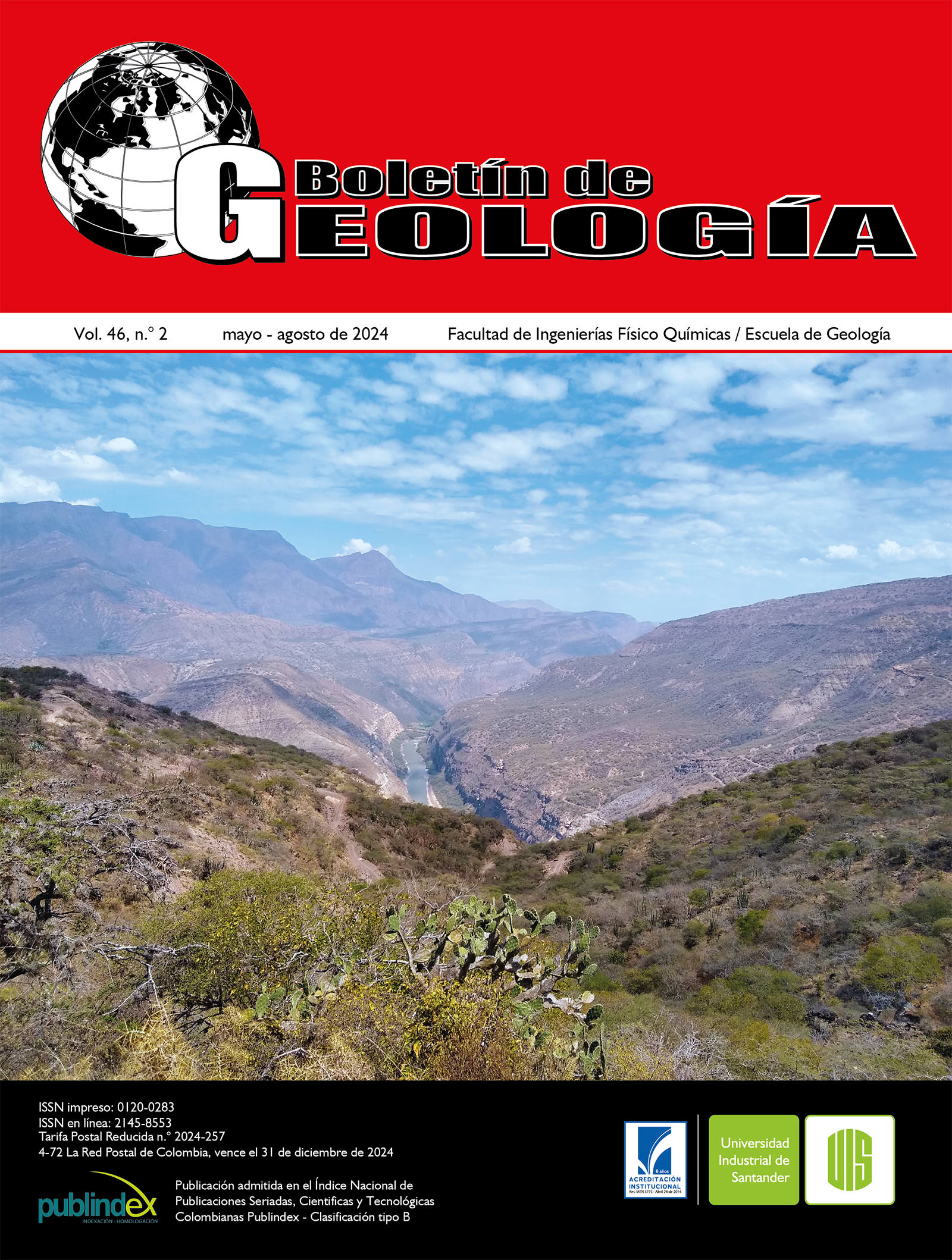Process mineralogy of monazite concentrate from gold mining (El Bagre, Colombia)
Published 2024-06-14
Keywords
- Black sands,
- Mineralogical characterization,
- Monazite,
- Rare earth elements
How to Cite
Copyright (c) 2024 Boletín de Geología

This work is licensed under a Creative Commons Attribution 4.0 International License.
Altmetrics
Abstract
In alluvial gold beneficiation, processes of heavy mineral concentration take place, many of which are of great economic interest. Among these, monazite is one of the most valuable, since it is an anhydrous orthophosphate of rare earth elements (ETRs), known for possessing extraordinary catalytic, electrical, magnetic, and optical properties. For this study, concentrate samples from the process tails of an alluvial gold operation, in El Bagre-Antioquia were used. The sample was subjected to gravimetric concentration, magnetic and electrostatic separation, in order to obtain monazite concentrate as pure as possible. To optimize the mineralogical characterization, the concentrate was separated into several granulometric fractions, from which grains from the coarsest fractions were selected using a binocular loupe, to be subsequently analyzed by FTIR and SEM, as support, for interpreting XRD results. Six main mineral phases were found: monazite, clinochlore, almandine, clinozoisite, zircon and ferroactinolite. Additionally, other minerals were identified in smaller quantities such as calcite, phlogopite, siderite, dolomite, quartz, ferrosilite and chromite, indicating that the concentration process was not efficient and could have negative effects on the extraction processes of ETRs, resulting in impure products. In this regard, improvements to the current monazite concentration process are proposed, based on the results of process mineralogy and the differences in their gravimetric, magnetic, and electrostatic susceptibilities.
Downloads
References
- Abe, T.; Kuribayashi, T.; Nakamura, M. (2017). Infrared spectroscopic study of OH defects in monazite. European Journal of Mineralogy, 29(6), 949-957. https://doi.org/10.1127/ejm/2017/0029-2663
- Amer, T.E.; Abdella, W.M.; Wahab, G.M.A.; El-Sheikh, E.M. (2013). A suggested alternative procedure for processing of monazite mineral concentrate. International Journal of Mineral Processing, 125, 106-111. https://doi.org/10.1016/j.minpro.2013.10.004
- Anthony, J.W.; Bideaux, R.A.; Bladh, K.W.; Nichols, M.C. (2003). Handbook of Mineralogy: Vol. 4. Arsenates, Phosphates, Vanadates. Mineralogical Society of America. https://doi.org/10.2113/gscanmin.38.6.1487
- ASTM D422-63. Standard test method for particle size analysis of soils. ASTM International, West Conshohocken, PA, 1998. https://doi.org/10.1520/D0422-63R98
- Campopiano, A.; Olori, A.; Cannizzaro, A.; Iannò, A.; Capone, P.P. (2015). Quantification of Tremolite in Friable Material Coming from Calabrian Ophiolitic Deposits by Infrared Spectroscopy. Journal of Spectroscopy, 2015, 974902. https://doi.org/10.1155/2015/974902
- Cataño, L.C. (1992). Recuperación de minerales pesados a partir de arenas negras aluviales. Trabajo de grado, Universidad Nacional de Colombia.
- Chukanov, N.V. (2014). Infrared spectra of mineral species. Springer Dordrecht. https://doi.org/10.1007/978-94-007-7128-4
- Cornelius, H.; Cornelis, K. (1982). Manual de mineralogía de DANA. Reverté.
- Demol, J.; Ho, E.; Soldenhoff, K.; Senanayake, G. (2019). The sulfuric acid bake and leach route for processing of rare earth ores and concentrates: A review. Hydrometallurgy, 188, 123-139. https://doi.org/10.1016/j.hydromet.2019.05.015
- Evans, A.M. (1992). Ore Geology and Industrial Minerals: An Introduction. Geoscience texts. (Third. edition). Blackwell Science Ltd. https://doi.org/10.1016/0169-1368(94)90015-9
- Ganguli, R.; Cook, D.R. (2018). Rare earths: A review of the landscape. MRS Energy & Sustainability, 5(1). https://doi.org/10.1557/mre.2018.7
- González-Clemente, O.J.; Bezada-Díaz, M.; Millán-Boadas, Z.; Carrera, J.M. (2014). Caracterización de las arenas y arcillas minerales de depósitos de canal y planicie de inundación del río Portuguesa, Venezuela. Investigaciones Geográficas, 85, 18-32. https://doi.org/10.14350/rig.35291
- Gupta, A.; Yan, D. (2016). Gravity Separation. In: Mineral Processing Design and Operations: An Introduction. (563-687). 2nd edition, Elsevier. https://doi.org/10.1016/B978-0-444-63589-1.00016-2
- Heuser, J.; Bukaemskiy, A.A.; Neumeier, S.; Neumann, A.; Bosbach, D. (2014). Raman and infrared spectroscopy of monazite-type ceramics used for nuclear waste conditioning. Progress in Nuclear Energy, 72, 149-155. https://doi.org/10.1016/j.pnucene.2013.09.003
- Kerguelen, J.L. (2016). Caracterización y aprovechamiento de recursos minerales en colas de terrazas aluviales del distrito Bagre-Nechí. Tesis de maestría, Universidad Nacional de Colombia.
- Krishnamurthy, N.; Gupta, C.K. (2015). Extractive metallurgy of rare earths. Taylor & Francis Group. (second edition). https://doi.org/10.1201/b19055
- Kumari, A.; Panda, R.; Jha, M.K.; Lee, J.Y.; Kumar, J.R.; Kumar, V. (2015). Thermal treatment for the separation of phosphate and recovery of rare earth metals (REMs) from Korean monazite. Journal of Industrial and Engineering Chemistry, 21, 696-703. https://doi.org/10.1016/j.jiec.2014.03.039
- Lamus, C.M. (2005). Mineralogía aplicada al uso y aprovechamiento de las arenas negras (El Bagre, Antioquia). Tesis de maestría, Universidad Nacional de Colombia.
- Mahmoud, A.; Cézac, P.; Hoadley, A.F.A.; Contamine, F.; D’Hugues, P. (2017). A review of sulfide minerals microbially assisted leaching in stirred tank reactors. International Biodeterioration and Biodegradation, 119, 118-146. https://doi.org/10.1016/j.ibiod.2016.09.015
- Merritt, R.R. (1990). High temperature methods for processing monazite: I. Reaction with calcium chloride and calcium carbonate. Journal of The Less-Common Metals, 166(2), 197-210. https://doi.org/10.1016/0022-5088(90)90001-Z
- Moustafa, M.I.; Abdelfattah, N.A. (2010). Physical and chemical beneficiation of the egyptian beach monazite. Resource Geology, 60(3), 288-299. https://doi.org/10.1111/j.1751-3928.2010.00131.x
- Rejith, R.G.; Sundararajan, M. (2018). Combined magnetic, electrostatic, and gravity separation techniques for recovering strategic heavy minerals from beach sands. Marine Georesources and Geotechnology, 36(8), 959-965. https://doi.org/10.1080/1064119X.2017.1403523
- Rosenblum, S.; Brownfield, I.K. (2000). Magnetic susceptibilities of minerals. Open-File Report. US Geological Survey Open-File Report 99-529. Comprende Tabla 1, 10 p. https://doi.org/10.3133/ofr99529
- Rossi, G. (1990). Biohydrometallurgy. McGraw-Hill.
- Socrates, G. (2004). Infrared and Raman Characteristic Group Frequencies: Tables and Charts. Willey.
- Tranvik, E.; Becker, M.; Pålsson, B.I.; Franzidis, J.P.; Bradshaw, D. (2017). Towards cleaner production – Using flotation to recover monazite from a heavy mineral sands zircon waste stream. Minerals Engineering, 101, 30-39. https://doi.org/10.1016/j.mineng.2016.10.011
- Udayakumar, S.; Rezan, S.A.; Mohd, N.A.F.; Rama, P.T.A.; Takip, K.M.; Hazan, R. (2018). Characterization of Malaysian Monazite Concentrate for the Recovery of Thorium Dioxide. Journal of Physics: Conference Series, 1082, 012090. https://doi.org/10.1088/1742-6596/1082/1/012090
- Valderrama, L.; Poblete, R.; Contreras, C. (2005). Caracterización y concentración de muestras de arenas de caldera, Región de Atacama. Revista de la Facultad de Ingeniería-Universidad de Atacama, 19, 38-44.
- Zviagina, B.B.; Drits, V.A.; Dorzhieva, O.V. (2020). Distinguishing features and identification criteria for K-dioctahedral 1M micas (Illite-aluminoceladonite and illite-glauconite-celadonite series) from middle-infrared spectroscopy data. Minerals, 10(2), 153. https://doi.org/10.3390/min10020153

